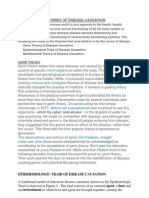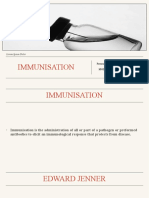0 ratings0% found this document useful (0 votes)
20 viewsIntroduction Imune System
Introduction Imune System
Uploaded by
LarasThis document discusses the history and evolution of immunology. It summarizes Edward Jenner's pioneering work in the late 18th century demonstrating that vaccination with cowpox provided protection against smallpox. It then describes how major advances since the 1960s, including new techniques like monoclonal antibodies and genetically modified animals, have transformed immunology from a descriptive to an explanatory science. The document goes on to outline the key distinction between innate immunity, which provides early defense, and adaptive immunity, which develops and strengthens in response to infection.
Copyright:
© All Rights Reserved
Available Formats
Download as DOCX, PDF, TXT or read online from Scribd
Introduction Imune System
Introduction Imune System
Uploaded by
Laras0 ratings0% found this document useful (0 votes)
20 views2 pagesThis document discusses the history and evolution of immunology. It summarizes Edward Jenner's pioneering work in the late 18th century demonstrating that vaccination with cowpox provided protection against smallpox. It then describes how major advances since the 1960s, including new techniques like monoclonal antibodies and genetically modified animals, have transformed immunology from a descriptive to an explanatory science. The document goes on to outline the key distinction between innate immunity, which provides early defense, and adaptive immunity, which develops and strengthens in response to infection.
Original Title
introduction imune system.docx
Copyright
© © All Rights Reserved
Available Formats
DOCX, PDF, TXT or read online from Scribd
Share this document
Did you find this document useful?
Is this content inappropriate?
This document discusses the history and evolution of immunology. It summarizes Edward Jenner's pioneering work in the late 18th century demonstrating that vaccination with cowpox provided protection against smallpox. It then describes how major advances since the 1960s, including new techniques like monoclonal antibodies and genetically modified animals, have transformed immunology from a descriptive to an explanatory science. The document goes on to outline the key distinction between innate immunity, which provides early defense, and adaptive immunity, which develops and strengthens in response to infection.
Copyright:
© All Rights Reserved
Available Formats
Download as DOCX, PDF, TXT or read online from Scribd
Download as docx, pdf, or txt
0 ratings0% found this document useful (0 votes)
20 views2 pagesIntroduction Imune System
Introduction Imune System
Uploaded by
LarasThis document discusses the history and evolution of immunology. It summarizes Edward Jenner's pioneering work in the late 18th century demonstrating that vaccination with cowpox provided protection against smallpox. It then describes how major advances since the 1960s, including new techniques like monoclonal antibodies and genetically modified animals, have transformed immunology from a descriptive to an explanatory science. The document goes on to outline the key distinction between innate immunity, which provides early defense, and adaptive immunity, which develops and strengthens in response to infection.
Copyright:
© All Rights Reserved
Available Formats
Download as DOCX, PDF, TXT or read online from Scribd
Download as docx, pdf, or txt
You are on page 1of 2
conditions.
Historically, the first clear example of this
manipulation, and one that remains among the most
dramatic ever recorded, was Edward Jenner's successful
vaccination against smallpox. Jenner, an English physician, noticed that milkmaids who had recovered from
cowpox never contracted the more serious smallpox. On
the basis of this observation, he injected the material
from a cowpox pustule into the arm of an 8-year-old boy.
When this boy was later intentionally inoculated
with smallpox, the disease did not develop. Jenner's
landmark treatise on vaccination (Latin vaccinus, of or
from cows) was published in 1798. It led to the widespread acceptance of this method for inducing immunity to
infectious diseases, and vaccination remains the
most effective method for preventing infections (Table
1-1). An eloquent testament to the importance of
immunology was the announcement by the World
Health Organization in 1980 that smallpox was the first
disease that had been eradicated worldwide by a
program of vaccination.
Since the 1960s, there has been a remarkable transformation in our understanding of the immune system
and its functions. Advances in cell culture techniques
(including monoclonal antibody production), immunochemistry, recombinant DNA methodology, x-ray
crystallography, and creation of genetically altered animals
(especially transgenic and knockout mice) have changed
immunology from a largely descriptive science into one
in which diverse immune phenomena can be explained
in structural and biochemical terms. In this chapter, we
outline the general features of immune responses and
introduce the concepts that form the cornerstones
of modern immunology and that recur throughout
this book.
INNATE AND ADAPTIVE IMMUNITY
Defense against microbes is mediated by the early reactions of innate immunity and the later responses of
adaptive immunity (Fig. 1-1 and Table 1-2). Innate
immunity (also called natural or native immunity) provides the early line of defense against microbes. It consists of
cellular and biochemical defense mechanisms
that are in place even before infection and are poised to
respond rapidly to infections. These mechanisms react
only to microbes (and to the products of injured cells),
and they respond in essentially the same way to repeated
infections. The principal components of innate immunity are (1) physical and chemical barriers, such as
epithelia and antimicrobial substances produced at
epithelial surfaces; (2) phagocytic cells (neutrophils,
macro phages) and natural killer (NK) cells; (3) blood
proteins, including members ofthe complement system
and other mediators of inflammation; and (4) proteins
called cytokines that regulate and coordinate many of
the activities of the cells of innate immunity. The mechanisms of innate immunity are specific for structures
that are common to groups of related microbes and
may not distinguish fine differences between foreign
substances.
In contrast to innate immunity, there are other
immune responses that are stimulated by exposure to
infectious agents and increase in magnitude and defensive capabilities with each successive exposure to a particular
microbe. Because this form of immunity develops
as a response to infection and adapts to the infection, it
is called adaptive immunity. The defining characteristics of adaptive immunity are exquisite specificity fo
You might also like
- Football Speed TrainingDocument6 pagesFootball Speed TrainingTBM607100% (1)
- Introduction To Immunology PDFDocument15 pagesIntroduction To Immunology PDFanon_143800659100% (1)
- Innate Immunity: Fig 1 Table IDocument9 pagesInnate Immunity: Fig 1 Table IforeveraldyNo ratings yet
- ImmunologyDocument38 pagesImmunologyquaisherhossainNo ratings yet
- Chunilal Mandal Paper2Document12 pagesChunilal Mandal Paper2Surbhi RawalNo ratings yet
- IVMS-Immune System NotesDocument17 pagesIVMS-Immune System NotesMarc Imhotep Cray, M.D.100% (1)
- Vaccine Immunology: Understanding Modern Vaccines: Perspectives in VaccinologyDocument35 pagesVaccine Immunology: Understanding Modern Vaccines: Perspectives in VaccinologyYulinda AswanNo ratings yet
- Zoology6thSem PDFDocument88 pagesZoology6thSem PDFRouf MalikNo ratings yet
- Theories of Disease Causation Level200Document5 pagesTheories of Disease Causation Level200Annan Agyekum JoshuaNo ratings yet
- Immunology and ImmunizationDocument241 pagesImmunology and Immunizationutop2385No ratings yet
- ImunologiDocument4 pagesImunologiDhiya NabilaNo ratings yet
- MLS326 Basic ImmunologyDocument28 pagesMLS326 Basic ImmunologyMayowa OgunmolaNo ratings yet
- Articulo Cientifico de InmunologiaDocument9 pagesArticulo Cientifico de InmunologiaAlejandra RomànNo ratings yet
- Immune System: From Wikipedia, The Free EncyclopediaDocument75 pagesImmune System: From Wikipedia, The Free EncyclopediaDewi PratiwiNo ratings yet
- Immunization New ContentDocument11 pagesImmunization New ContentkrishnasreeNo ratings yet
- Cellular and Molecular Immunology Module1: IntroductionDocument32 pagesCellular and Molecular Immunology Module1: IntroductionAygul RamankulovaNo ratings yet
- Recent Advances in Immunology Have Led To A Better Understanding of The Human Immune System and The MechaDocument2 pagesRecent Advances in Immunology Have Led To A Better Understanding of The Human Immune System and The MechaAzhara Rizki GitaNo ratings yet
- SCIENTISTSDocument5 pagesSCIENTISTSMarica Mae PreNo ratings yet
- ImmunologyDocument46 pagesImmunologyTempo RaryNo ratings yet
- Physio ImmunityDocument5 pagesPhysio Immunityobiero peterNo ratings yet
- Immunology & Immunological PreparationDocument129 pagesImmunology & Immunological PreparationBijayaKumarUprety67% (3)
- Innate ImunologiDocument1 pageInnate ImunologiLarasNo ratings yet
- Undergraduate Immunology Course (2018-2019) For Third Class: Biology Dept. College of ScienceDocument34 pagesUndergraduate Immunology Course (2018-2019) For Third Class: Biology Dept. College of ScienceAhmed Asaad Majid Al Mousawi100% (1)
- ImmunologyDocument16 pagesImmunologycarlynjihan.ortiz.b2017263No ratings yet
- Immunology Group3 Ass Micro 4TH Sem PDFDocument136 pagesImmunology Group3 Ass Micro 4TH Sem PDFKomal fatimaNo ratings yet
- ImmunologyDocument7 pagesImmunologyadelbaneen31No ratings yet
- Immunology and ImmunityDocument37 pagesImmunology and Immunityrahulyuva18No ratings yet
- VaccinesDocument32 pagesVaccinesA PANDUNo ratings yet
- IMMUNO MidtermsDocument95 pagesIMMUNO MidtermslarnieestebanNo ratings yet
- ImmunizationDocument320 pagesImmunizationbrightonjilloNo ratings yet
- L07: The Immune System and The Diseases of The Immune SystemDocument10 pagesL07: The Immune System and The Diseases of The Immune Systemhstest842No ratings yet
- VMC 221 Coursematerials PDFDocument61 pagesVMC 221 Coursematerials PDFavenger 2100% (1)
- Artificial Immunity Vs Natural ImmunityDocument87 pagesArtificial Immunity Vs Natural ImmunityromeoqfacebookNo ratings yet
- An Introduction To Immunology and ImmunopathologyDocument11 pagesAn Introduction To Immunology and ImmunopathologyImelda Lorenzette ArañaNo ratings yet
- Immunology Notes Part 1Document11 pagesImmunology Notes Part 1ashley griffithNo ratings yet
- An Introduction To SerologyDocument13 pagesAn Introduction To SerologyLeydi Yudith Angarita Bautista100% (1)
- AJPS Volume 64 Issue 2 Pages 41-68Document28 pagesAJPS Volume 64 Issue 2 Pages 41-68Mohamad MostafaNo ratings yet
- Class-9 Bio VaccinationDocument5 pagesClass-9 Bio VaccinationAayan RizviNo ratings yet
- Csa ExerciseDocument17 pagesCsa ExerciseBlack starNo ratings yet
- 15 Questions and Answers On Pathogens and ImmunityDocument3 pages15 Questions and Answers On Pathogens and Immunitymfenn1997100% (1)
- Aki Ola Shs Text BookDocument1 pageAki Ola Shs Text BookmargaretboronsumNo ratings yet
- Document 20230130151341Document23 pagesDocument 20230130151341dfang72No ratings yet
- Immunisation: Lorem Ipsum DolorDocument60 pagesImmunisation: Lorem Ipsum DolorDr. Ajeta GuptaNo ratings yet
- Innate Immunity: Fig 1 Table IDocument9 pagesInnate Immunity: Fig 1 Table IponbohacopNo ratings yet
- Immune SystemDocument17 pagesImmune SystemRomneck RoveroNo ratings yet
- Immune Response To Fungal Infections: Jose L. Blanco, Marta E. GarciaDocument24 pagesImmune Response To Fungal Infections: Jose L. Blanco, Marta E. Garciagagah152No ratings yet
- Running Head: ImmunologyDocument12 pagesRunning Head: ImmunologyMayaka AmosNo ratings yet
- Inmunologia Duane's OphthalmologyDocument29 pagesInmunologia Duane's OphthalmologyAlejandro SerranoNo ratings yet
- Weapons of Mass DistructionDocument13 pagesWeapons of Mass Distructionmysticdream100% (1)
- Tkacs Advanced Pathophysiology CH 6 The Immune SystemDocument60 pagesTkacs Advanced Pathophysiology CH 6 The Immune Systemnavin singhNo ratings yet
- M1 and M2 Macrophages Oracles of Health and DiseaseDocument26 pagesM1 and M2 Macrophages Oracles of Health and DiseaseCristian Gutiérrez VeraNo ratings yet
- Sysmex SEED Haematology InflammatoryDocument7 pagesSysmex SEED Haematology InflammatoryTzeto Han CongNo ratings yet
- CH 8Document13 pagesCH 8HayderNo ratings yet
- Immuno Log IDocument57 pagesImmuno Log IRoby KieranNo ratings yet
- The Selfish Immune System When The Immune System Overrides The - Selfish - Brain (#676988) - 936333Document34 pagesThe Selfish Immune System When The Immune System Overrides The - Selfish - Brain (#676988) - 936333Sara CorregidorNo ratings yet
- Advanced Medicineprize2011Document18 pagesAdvanced Medicineprize2011Ivan Farroñay AntónNo ratings yet
- Immunology Unveiled: A Comprehensive Journey through the Human Immune System: Guardians of the Body: The Unseen Heroes of ImmunityFrom EverandImmunology Unveiled: A Comprehensive Journey through the Human Immune System: Guardians of the Body: The Unseen Heroes of ImmunityNo ratings yet
- Vaccination: How Millions of Lives Have Been Saved - Perhaps YoursFrom EverandVaccination: How Millions of Lives Have Been Saved - Perhaps YoursNo ratings yet
- Immuniverse: Unlocking Your Body's Innate Power for Immune Enhancement: Nutrition & Diet Edition, #2From EverandImmuniverse: Unlocking Your Body's Innate Power for Immune Enhancement: Nutrition & Diet Edition, #2No ratings yet
- Chief ComplainsDocument1 pageChief ComplainsLarasNo ratings yet
- Hasil Penelitian Hub. Antara TCM Dan LEDDocument2 pagesHasil Penelitian Hub. Antara TCM Dan LEDLarasNo ratings yet
- JurnalDocument1 pageJurnalLarasNo ratings yet
- Innate ImunologiDocument1 pageInnate ImunologiLarasNo ratings yet
- Water (H2o) Molecules Form Hydrogen BondsDocument1 pageWater (H2o) Molecules Form Hydrogen BondsLarasNo ratings yet
- How Is The Body Organized? Source: Vander's Human Physiology, 13 EditionDocument3 pagesHow Is The Body Organized? Source: Vander's Human Physiology, 13 EditionLarasNo ratings yet
- The Thyroid Gland: Triiodothyronine (T) Tetraiodothyronine Thyroxine (T) Calcitonin TyrosineDocument1 pageThe Thyroid Gland: Triiodothyronine (T) Tetraiodothyronine Thyroxine (T) Calcitonin TyrosineLarasNo ratings yet
- How Is The Body Organized? Source: Vander's Human Physiology, 13 EditionDocument1 pageHow Is The Body Organized? Source: Vander's Human Physiology, 13 EditionLarasNo ratings yet
- Water Molecules Form Hydrogen BondsDocument1 pageWater Molecules Form Hydrogen BondsLarasNo ratings yet
- The Endocrine Glands: Pituitary Gland HypophysisDocument1 pageThe Endocrine Glands: Pituitary Gland HypophysisLarasNo ratings yet
- The EndocrineDocument1 pageThe EndocrineLarasNo ratings yet
- The Pineal GlandDocument1 pageThe Pineal GlandLarasNo ratings yet
- Hormones: Target CellsDocument2 pagesHormones: Target CellsLarasNo ratings yet
- Hormones: Target CellsDocument2 pagesHormones: Target CellsLarasNo ratings yet
- Edexcel IGCSE IGCSE Biology (4325) : This Examiners' Report Relates To Mark Scheme Publication Code: UG018554Document12 pagesEdexcel IGCSE IGCSE Biology (4325) : This Examiners' Report Relates To Mark Scheme Publication Code: UG018554muhajireenNo ratings yet
- Medicinal Chemistry - KDKDocument54 pagesMedicinal Chemistry - KDKistri kyungsoNo ratings yet
- Scientific Career of Dr. Jaime Lagunez OteroDocument42 pagesScientific Career of Dr. Jaime Lagunez OteroFrente CivicoNo ratings yet
- Protein Debate: Performance MenuDocument33 pagesProtein Debate: Performance MenuJonasongNo ratings yet
- To Miss CarmelaDocument2 pagesTo Miss CarmelaAkeem Emmanuel Uy FeriaNo ratings yet
- Other Blood GroupsDocument3 pagesOther Blood GroupsodysseypaulsilorioNo ratings yet
- Inflammation PDFDocument101 pagesInflammation PDFman5jo5nz100% (2)
- Club FootDocument47 pagesClub FootSujanaNo ratings yet
- Cancer of Reproductive SystemDocument42 pagesCancer of Reproductive SystemPia SempronNo ratings yet
- Aymerich, 2004Document10 pagesAymerich, 2004Belen VignolaNo ratings yet
- Ise Genetics: From Genes To Genomes (Ise Hed WCB Cell & Molecular Biology) 7Th Edition Michael L. Goldberg MD - Ebook PDFDocument49 pagesIse Genetics: From Genes To Genomes (Ise Hed WCB Cell & Molecular Biology) 7Th Edition Michael L. Goldberg MD - Ebook PDFdhorzthiky100% (5)
- Lifestyle of A Hypertensive Middle Adult in Poblacion, Sta. MariaDocument8 pagesLifestyle of A Hypertensive Middle Adult in Poblacion, Sta. Marianadaime15No ratings yet
- Rhythms of Life - Circadian Disruption and Brain Disorders Across The LifespanDocument17 pagesRhythms of Life - Circadian Disruption and Brain Disorders Across The LifespanMakanudo.No ratings yet
- 8 Endometrial Carcinoma - Libre PathologyDocument7 pages8 Endometrial Carcinoma - Libre PathologyfadoNo ratings yet
- Roll. No Name Project Topic: Affiliation No: 2133841 School Code: 71901Document6 pagesRoll. No Name Project Topic: Affiliation No: 2133841 School Code: 71901roastedladkaNo ratings yet
- Introduction To Affymetrix MicroarraysDocument43 pagesIntroduction To Affymetrix MicroarraysEmanuel EmiNo ratings yet
- Sat Written Test Question 002 (10:2)Document5 pagesSat Written Test Question 002 (10:2)Jihan AfnanNo ratings yet
- Cell Differentiation and Organogenesis 2Document34 pagesCell Differentiation and Organogenesis 2Dahal Babin100% (1)
- Y13 Biology Christmas Exam TechniqueDocument35 pagesY13 Biology Christmas Exam TechniqueSimon AwberyNo ratings yet
- Beyond Safety: Mapping The Ethical Debate On Heritable Genome Editing InterventionsDocument14 pagesBeyond Safety: Mapping The Ethical Debate On Heritable Genome Editing InterventionsJuan Jose Herrera ZaballaNo ratings yet
- KRAS G12D MutationsDocument13 pagesKRAS G12D Mutationslol pookNo ratings yet
- February April 2009 Part 2 FRCOphth Examination Final ReportDocument20 pagesFebruary April 2009 Part 2 FRCOphth Examination Final Reportsafasayed0% (1)
- Heterocyclic CompoundsDocument26 pagesHeterocyclic Compounds29decNo ratings yet
- Transplantation ImmunologyDocument36 pagesTransplantation ImmunologysuvendumitraNo ratings yet
- GeneticsDocument23 pagesGeneticsmianskNo ratings yet
- 3B-EXOME, Proband: PositiveDocument6 pages3B-EXOME, Proband: PositiveGenetic Clinic UKMNo ratings yet
- Potent and Specific Genetic Interference by Double-Stranded RNA in Caenorhabditis ElegansDocument8 pagesPotent and Specific Genetic Interference by Double-Stranded RNA in Caenorhabditis ElegansfrostyNo ratings yet
- Potential of CRISPR Cas System in The Diagnosis of COVID 19 InfectionDocument12 pagesPotential of CRISPR Cas System in The Diagnosis of COVID 19 InfectionHillaryNo ratings yet
- MCQS On History-WPS OfficeDocument18 pagesMCQS On History-WPS Officeadebiyibisola2020No ratings yet





































































































